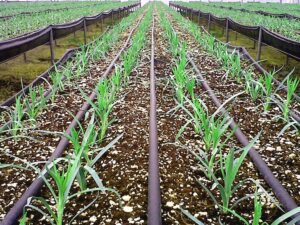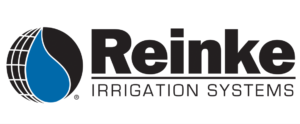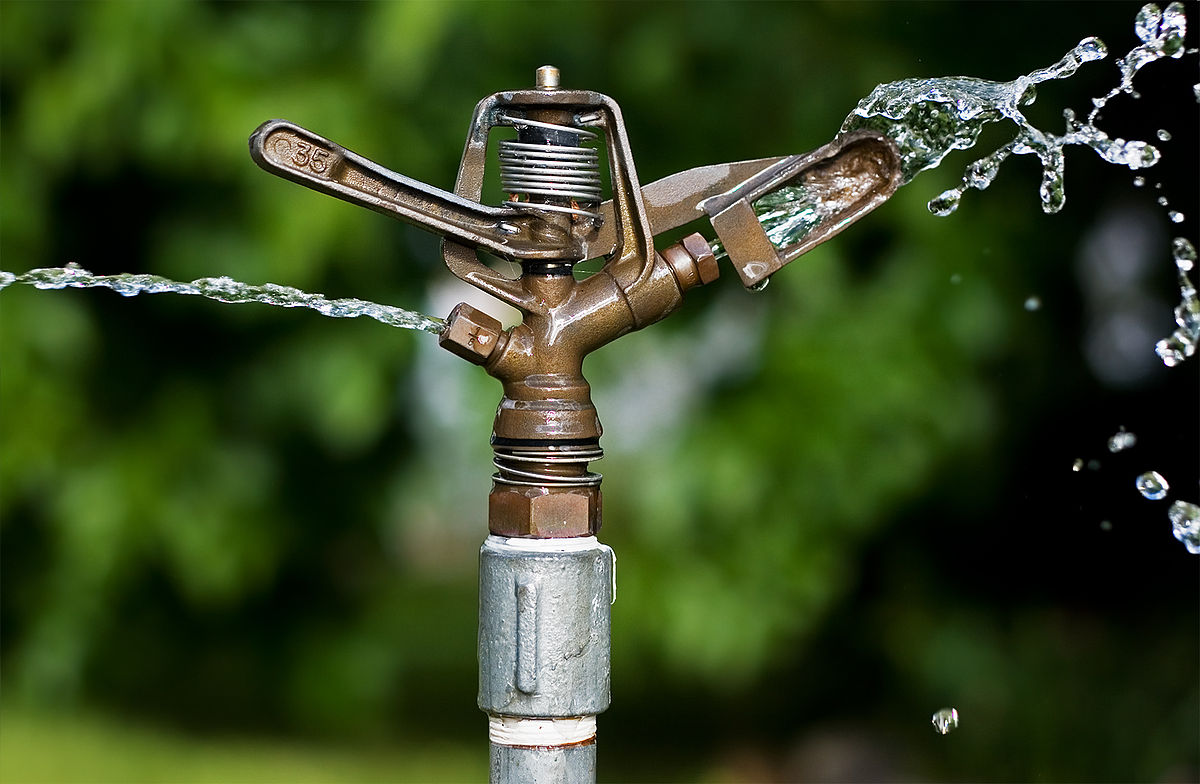Irrigation concepts and terminology
Agricultural Drainage It is removal of excess water known as free or gravitational water from the surface or below the surface of farm land to create favourable condition for proper growth and development of the plot.
Application Efficiency
The ratio of the water that is stored in the root zone for later use by the plants to the total water applied.
Available Water Capacity (AWC)
Also known as available water (AW). The portion of water in a soil that can be readily absorbed by plant roots. It is the amount of water between field capacity and permanent wilting point.
Best Management Practice (BMP)
An irrigation practice that is both economical and practical that will assist in reducing water use, protect water quality, while maintaining or improving crop production.
Big Gun Systems
Uses a large sprinkler mounted on a wheeled cart or trailer, fed by a flexible rubber hose. The machine may be reeled in by the hose, or moved periodically. Big guns operate at high operating pressures in order to throw water long distances.
Center Pivot Sprinklers
An automated irrigation system composed of a sprinkler lateral rotating around a pivot point and supported by a number of self-propelled towers. Water and power is supplied at the pivot point. They are easily identified from the air as large circular fields.
Chemigation
The process of applying chemicals (fertilizers, insecticides, herbicides, etc…) to crops or soil through an irrigation system with the water.
Deep Percolation
Movement of water downward through the soil profile below the root zone. This water is lost to the plants and eventually ends up in the groundwater. These water losses can be significant and are often out-of-site and therefore out-of-mind.
Drip Irrigation
Also known as trickle or micro-irrigation. Water is applied at very low flow rates (drip) through emitters directly to the soil. Emitter flow rates are generally less than 3 gallons per hour.
Effective Precipitation
Portion of the total precipitation that is stored in the soil profile for later use by the plants. [in, mm]
Efficiency
See application efficiency, irrigation efficiency, conveyance efficiency, pumping plant efficiency, motor efficiency, pump efficiency, or water use efficiency. [%, decimal]
Emitter
Also known as a dripper. Used in drip irrigation to control the flow of water into the soil.
Evaporation
Loss of water as vapor from the soil surface or wet leaves. Differs from transpiration in that the water does not pass through the plant leaves.
Evapotranspiration (ET)
Combined water lost from both transpiration from plant leaves and evaporation from soil and wet leaves. Also known as crop water use, or consumptive use. The crop ET (ETc) can be estimated by calculating the reference ET for a particular reference crop (ETo for clipped grass, and ETr for alfalfa) from weather data and multiplying this by a crop coefficient.
Fertigation
Application of fertilizers through the irrigation system. A form of chemigation.
Field Capacity (FC)
Maximum amount of water that a soil can hold indefinitely against gravity. Put another way it is the amount of water left in the soil after all the free water has had a chance to drain out through the force of gravity.
Flood Irrigation
Also known as wild flood irrigation. Water is turned into a field without any flow control such as furrows, boarders or corrugations. This is the least efficient, least uniform and least effective method of irrigation.
Friction loss
Pressure losses caused by friction of the water on the pipe walls and turbulence inside the pipe. Friction losses are a function of the pipe length, the pipe’s inside diameter, the pipe material, and the flow rate.
Furrow Irrigation
Also known as rill irrigation. Water is applied to row crops in small ditches or channels between the rows made by tillage implements.
Gated Pipe
Portable pipe that is placed at the top of the field. It has small gates in the sides that are opened to allow water to flow into furrows.
Hydroscopic Water
That water is adsorbed from an atmosphere of water vapour because of attractive forces in the surface of particles.
Hysteresis
It is the log of in one of the two associated process or phenomena during reversion.
Indicator Plant
It is the plant, which reflects specific growing condition by its presence or character of growth.
Infiltration Rate
It is the maximum rate at which a soil under given condition and at given time can absorb water when there is no divergent flow at borders
Intake Rate or Infiltration Velocity It is the rate of water entry into the soil expressed as a depth of water per unit area applicable or divergence of flow in the soil.
Irrigation Requirement It refers to the quantity of water, exclusive of precipitation, required for crop production. This amounts to net irrigation requirement plus other economically avoidable losses. It is usually expressed in depth for given time.
Infiltration Rate
Rate at which water can enter the soil. Usually measured in units of depth per unit time (mm/hr).
Intake Rate (Basic)
Rate at which water enters the soil after infiltration has decreased to a low and nearly constant value. This value should be used for sprinkler and drip irrigation system designs.
Irrigation Efficiency
Proportion of the water that is beneficially used to the irrigation water applied.
Irrigation Scheduling
Process of determining when to irrigate and how much. This can be done by monitoring the soil, the crop, or calculating water use (evapotranspiration). The goal is to schedule irrigation timing and amounts such that the soil water content remains between field capacity and the management allowable deficit.
Leaching: It is removal of soluble material by the passage of water through the soil.
Leaching Requirement: It is the fraction of water entering the soil that must pass through the root zone in order to prevent soil salinity from exceeding a specific value.
LEPA (Low-Energy Precision Application)
The use of drop tubes on a center pivot or lateral-move systems to apply water at low pressures very near or directly onto the soil surface. This increases efficiency and uniformity. Furrow dikes are typically required to avoid runoff. Often confused with LESA (low elevation spray application) and MESA (mid elevation spray application).
Nozzle
Final orifice through which water passes from the sprinkler to the atmosphere. Sprinkler flow rate is largely determined by the nozzle size (orifice diameter) and pressure.
Oasis effect: It is the exchange of heat whereby air over crop is cooled to supply heat for evaporation.
Operating Pressure
Average pressure at sprinkler heads.
Osmotic Potential
The equivalent force that a salinity differential can cause across a semi-permeable membrane (plant root). [bars, kPa]

Irrigation system
Percolation
It is the down word movement of water through the soil.
Permanent Wilting Point (PWP): Permanent wilting point is the moisture content in percentage of soil at which nearly all plants wilt and do not recover in a humid dark chamber unless water is added from an outside source. This is lower limit of available moisture range for plant growth ceases completely. The force with which moisture is held by dry soil this point corresponds to 15 atmospheres.
Permeability: Permeability is the property of a porous medium to transmit fluids It is a broad term and can be further specified as hydraulic conductivity and intrinsic permeability.
PF: It is the logarithm of height in cm of column of water which represents the total stress with which water is held by soil.
PH: It is the negative logarithm of hydrogen ion concentration.
Potential Evaporation: It represents evaporation from a large body of free water surface. It is assumed that, there is no effect of addictive energy. It is primarily a function of evaporative demand of climate.
Potential Evapo-transpiration: It is the amount of water evaporated in a unit time from short uniform green crop growing actively and covering an extended surface and never short of water. Penman prefers the term potential transpiration.
Pressure
The measurement of force within a system. This is the force that moves water through pipes, sprinklers and emitters. Static pressure is measured when no water is flowing and dynamic pressure is measured when water is flowing. Pressure and flow are affected by each other. [bars, psi, kPa]
Pressure Regulator
A device that maintains a constant downstream pressure (can not increase pressure).
Pump
Converts mechanical energy into hydraulic energy (pressure and/or flow). A centrifugal pump is the most common type used for irrigation.
Root Zone
Also referred to as the root depth or effective rooting depth. The depth or volume of soil from which plants effectively extract water from. Typically this is defined as the depth of soil containing 80 percent of the plant roots. [ft, m]
Salinity (Saline)
Concentration of salts in irrigation water. High concentrations can limit the crops ability to take up and use the water in the soil.
Sprinkler Irrigation
Irrigation water is applied through a pressurized system. The pressure causes the water to flow out through the sprinkler nozzle and fly through the air and falls onto the soil surface. Commonly used agricultural sprinkler irrigation systems include center pivots, wheel lines, hand lines, solid set, and big guns.
Sprinkler Spacing
An individual pipe section length.
Subirrigation
Water is applied to open ditches or to tile lines to bring the water table up to where it is high enough to be used by the plants. Typically this is only practical in locations with high water tables, flat ground, and sandy soils.
Surface Irrigation
Irrigation method where the soil surface is used to transport the water via gravity flow from the source to the plants. Common surface irrigation methods are furrow irrigation, corrugation irrigation, border irrigation, basin irrigation, and flood irrigation.
Surge Irrigation
Water is sent down a furrow in pulses. After the initial surge, the furrow is allowed to dry. This wetting and drying cycle continues throughout the whole irrigation event. Surge increases uniformity for furrow irrigation and increases application efficiency.
System Capacity
The ability of an irrigation system to deliver water to an acreage.
Seepage
It is the water escaped through the soil under gravitational forces.
Surface Drainage: when the excess water saturates the pores spaces removal of water of water by downward flow through the soil is called subsurface drainage.
Transpiration
Water taken up by the plant’s roots and transpired out of the leaves.
Water Horsepower
The energy or power added to water by the pump. [hp, kW]
Water Table
The upper surface of a saturated zone below the soil surface where the water is at atmospheric pressure. If you dig a hole deep enough water will start filling the hole at the water table.











It’s good that you mentioned agricultural drainage and how it involves removing excess water from the surface or below it for us to create favorable conditions for the proper growth of our crops. I need proper drainage for the farm fields I recently invested in Norfolk if I want to make sure my new property gives me great produce later to sell to local markets. I’ll keep this in mind while I look for experts in farm field tiling operating in Norfolk to hire for the drainage my farm property needs soon. https://plumbingandelectricservice.com/farm-tilling